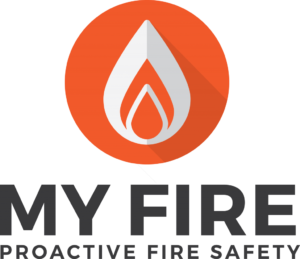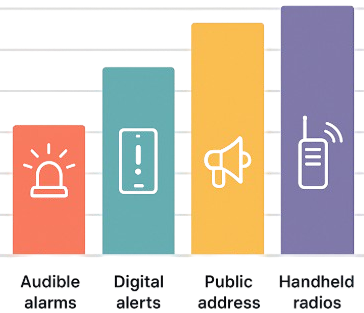Emergency Evacuation Planning for Large-Scale Industrial Sites
A well-structured evacuation plan is critical for protecting workers in large industrial facilities.
 With complex layouts, hazardous materials, and hundreds, or even thousands, of employees, having a clear, well-rehearsed strategy can mean the difference between safety and catastrophe.
With complex layouts, hazardous materials, and hundreds, or even thousands, of employees, having a clear, well-rehearsed strategy can mean the difference between safety and catastrophe.
But how do you ensure your plan stays relevant as conditions change? Regular updates, continuous training, and employee engagement are key. Let’s explore how you can build and maintain an effective evacuation strategy.
Identifying Potential Hazards
Before crafting an evacuation plan, you must first identify all potential hazards. In industrial sites, these hazards can vary widely depending on the industry, facility size, and location.
Common Hazards in Industrial Settings:
Industrial fires can have devastating consequences, making it essential to understand their common causes. By identifying and addressing these hazards, businesses can significantly reduce the risk of fire incidents.
1. Electrical Equipment Malfunctions
Faulty electrical equipment is a leading cause of industrial fires. Issues such as overloaded circuits, poor maintenance, and aging wiring can lead to overheating and sparks, igniting nearby combustible materials. Regular inspection and maintenance of electrical systems are vital to prevent such occurrences.
2. Improper Handling and Storage of Flammable Materials
Many industrial processes involve flammable substances like chemicals, gases, and combustible dust. Incorrect storage or handling of these materials can create explosive atmospheres. Ensuring proper storage, adequate ventilation, and adherence to safety protocols can mitigate these risks. HSE+1HSE+1
3. Hot Work Processes
Operations such as welding, cutting, and grinding produce sparks and heat, posing significant fire hazards if conducted near flammable materials. Implementing strict hot work procedures, including permits and fire watches, helps in minimizing these dangers.
Other common causes of fires in industrial settings include:
🔹Chemical Spills
🔹Combustible Dust Accumulation
🔹Equipment Overheating
🔹Smoking in Prohibited Areas
🔹Arson
How to Mitigate Risks
Conduct regular fire risk assessments, engage employees in hazard identification, keep emergency exits clear and accessible, & ensure fire suppression systems are up to date.

💡 Real-life Case: The 2005 Buncefield Oil Storage Fire
The Buncefield oil storage fire in Hertfordshire is a stark reminder of the dangers of overlooking potential hazards. The explosion was caused by an accumulation of flammable vapors, resulting from inadequate safety measures at the site.
This incident emphasizes the critical importance of identifying chemical hazards, especially in sites that handle volatile substances.
Properly assessing and managing risks like fuel vapors can prevent catastrophic events like the one that occurred at Buncefield.
You may also like: Improving Fire Safety in UK Factories: Compliance & Best Practices
Developing an Evacuation Plan
The foundation of any effective evacuation plan starts with well-marked exit routes. Pathways should be clearly signposted and lit with emergency lighting, even during power outages.
It’s just as important to have safe assembly points, designated areas away from danger where staff can gather and be accounted for after evacuating. In larger industrial facilities, these points must be accessible and large enough to handle the number of people expected.
Roles and responsibilities during an evacuation should be clearly assigned in advance. This might include fire wardens, who guide others and check that no one is left behind, or first-aid responders who support injured colleagues. Alternative exit routes should also be built into the plan in case the main paths become blocked or unsafe.
Need expert fire safety support for your factory or industrial site?
Speak to our team today — we’re here to help.
📞 Call us FREE on 0800 999 11 25
Accessibility is another critical part of planning. Your evacuation strategy should account for employees with disabilities or mobility challenges, ensuring that everyone can get out safely. The UK Government’s guidance on fire safety risk assessments recommends identifying vulnerable individuals and tailoring emergency procedures to their needs.
Above all, your evacuation plan should be a living document. Test it often through drills, listen to feedback, and adapt it to meet the unique needs of your industrial site.
💡 Real-life Case: The 1988 Poole Explosion serves as a pertinent example for the “Developing an Evacuation Plan” section.
On June 21, 1988, a significant explosion occurred at the BDH chemical plant in Poole, Dorset. The incident led to the evacuation of approximately 3,500 people, marking one of the largest peacetime evacuations in the UK since World War II.
Despite the explosion’s intensity, there were no fatalities or serious injuries, largely due to the effective evacuation plan in place. Wikipedia
Key elements of the evacuation plan that contributed to its success included:
🔹Clear Exit Routes: Marked pathways and emergency lighting facilitated swift and safe evacuations.
🔹Assembly Points: Designated safe locations ensured that evacuees could be accounted for and receive necessary assistance.
🔹Emergency Roles: Assigned responsibilities among staff and emergency personnel streamlined the evacuation process.
🔹Alternative Routes: Backup exits were available in case primary routes were blocked or unsafe.
🔹Accessibility Considerations: Provisions were made to assist individuals with mobility challenges, ensuring that all employees could evacuate safely.
Evacuation Plan Checklist:
✔️ Clearly marked exits
✔️ Emergency lighting in place
✔️ Regularly reviewed and updated
✔️ Includes provisions for special-needs employees
✔️ Employees assigned specific roles
You may also like: The Hidden Dangers of Combustible Dust in Factories
Communication Strategies
In an emergency, clear communication can be the difference between calm and chaos. When every second counts, people need to know exactly what’s happening and what they should do.

That’s why it’s vital to have fast, reliable communication systems built directly into your fire safety protocols. Without them, confusion can spread just as quickly as the fire itself.
A strong communication plan should include a range of tools. Audible alarms and sirens provide immediate warning and should be distinct enough to indicate different types of emergencies.
Digital alerts, like SMS messages, emails, or push notifications, help ensure that all staff, even those off-site or on break, get real-time updates.
Public address systems allow key messages to be broadcast across the facility, while handheld radios give safety coordinators direct lines to each other during fast-moving situations.
Each of these tools plays a role in keeping your evacuation organised, safe, and under control.
Training and Drills
Evacuation plans are useless without practice. Regular drills, guided by your fire strategy plan, ensure employees know what to do when an emergency occurs.
How Often Should You Conduct Drills?
| Training Focus | Frequency | Participants | Objectives |
|---|---|---|---|
| 🔁 Evacuation Procedures | Quarterly | All employees | Ensure everyone knows exit routes and assembly points. |
| 🛠️ Emergency Equipment Use | Semi-annually | Designated personnel | Train selected staff to use fire extinguishers, alarms, and emergency tools. |
| 🎭 Scenario-Based Drills | Bi-annually | Selected teams | Simulate real emergencies to test readiness and improve response time. |
🔹 Tip: Conduct surprise drills to test real-time readiness.
Evaluating and Updating Your Plan
Your evacuation plan should evolve with your facility. Regular evaluations ensure it remains effective and compliant with UK fire safety standards
Steps to Keep Your Plan Updated:
✔️ Review Annually: Ensure procedures align with current operations.
✔️ Incorporate Feedback: Learn from drills and real incidents.
✔️ Stay Up-to-Date on Regulations: Check updates from UK Health and Safety Executive (HSE) and local fire authorities.
✔️ Audit Emergency Equipment: Check fire extinguishers, alarms, and first-aid kits regularly.
📊 Industry Data: According to the UK Health and Safety Executive (HSE), businesses that fail to review and update their emergency plans regularly are more likely to experience significant disruption and legal consequences following a serious incident. Don’t let your business fall behind on safety standards.
You may also like: Understanding Fire Load in Factories: How Storage Impacts Fire Risk
Conclusion
A well-designed emergency evacuation plan is essential for industrial sites. From hazard identification to regular training, every aspect of your plan must be thorough and consistently updated.
By investing in preparedness, you protect not only your employees but also the future of your business. Start today—evaluate your current plan, implement improvements, and conduct a drill to reinforce safety in your workplace.
🚀 Next Steps:
Step 1: Conduct a facility-wide risk assessment.
Step 2: Schedule your next emergency drill.
Step 3: Update communication systems for better crisis response.
Stay safe. Stay prepared. 🔥
You may also like: Adapting Fire Safety Measures for High-Risk Manufacturing Sectors
If you have any questions or would like to talk to us about fire safety at your factory, give us a call on 0800 999 11 25 or drop us a message
My Fire Safety. Co-Space, 25 Town Square,
Stevenage, SG1 1BP.
Related Fire Safety Training Courses:
Fire Extinguisher Training
Regular Refresher Training
Fire Marshal Training
Fire Alarm Training

Sorry, the comment form is closed at this time.